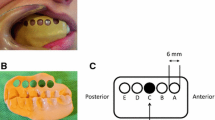Abstract
Objective: We wanted to test whether assessment of both a central pain-related signal (chemo-somatosensory evoked potential, CSSEP) and a concomitantly recorded peripheral signal (negative mucosal potential, NMP) allows for separation of central and peripheral effects of NSAIDs. For this purpose, experimental conditions were created in which NSAIDs had previously been observed to produce effects on phasic and tonic pain by either central or peripheral mechanisms.
Methods: According to a double-blind, randomised, controlled, threefold cross-over design, 18 healthy subjects (11 males, 7 females; mean age 26 years) received either placebo, 400 mg ibuprofen, or 800 mg ibuprofen. Phasic pain was applied by means of short pulses of CO2 to the nasal mucosa (stimulus duration 500 ms, interval approximately 60 s), and tonic pain was induced in the nasal cavity by means of dry air of controlled temperature, humidity and flow rate (22 °C, 0% relative humidity, 145 ml · s−1). Both CSSEPs as central and NMPs as peripheral correlates of pain were obtained in response to the CO2 stimuli. Additionally, the subjects rated the intensity of both phasic and tonic pain by means of visual analogue scales.
Results: As described earlier, administration of ibuprofen was followed by a decrease in tonic pain but – relative to placebo – an increase in correlates of phasic pain, indicating a specific effect of ibuprofen on the interaction between the pain stimuli under these special experimental conditions. Based on the similar behaviour of CSSEP and NMP, it was concluded that the pharmacological process underlying this phenomenon was localised in the periphery. By means of the simultaneous recording of interrelated peripheral and central electrophysiologic correlates of nociception, it was possible to separate central and peripheral effects of an NSAID. The major advantage of this pain model is the possibility of obtaining peripheral pain-related activity directly using a non-invasive technique in humans.
Similar content being viewed by others
Author information
Authors and Affiliations
Additional information
Received: 19 May 1996 / Accepted in revised form: 14 November 1996
Rights and permissions
About this article
Cite this article
Lötsch, J., Hummel, T., Kraetsch, H. et al. The negative mucosal potential: separating central and peripheral effects of NSAIDs in man. E J Clin Pharmacol 52, 359–364 (1997). https://doi.org/10.1007/s002280050301
Issue Date:
DOI: https://doi.org/10.1007/s002280050301




